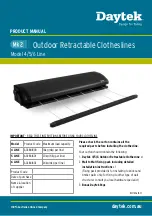
Responsibilities of the Designer
Not withstanding the natural effects mentioned above it is still
the responsibility of the designer of the rainwater goods system
(who may be the architect, builder, hydraulic engineer, home
owner, roofing or guttering contractor) to design a rainwater
system which allows adequate drainage to occur. Water should
not be able to flow back into the building.
• For eaves gutters they must determine the rainfall intensity
values (ARI) shown in AS3500 part 3.2 “Stormwater drainage
– Acceptable solutions”.
• For a specific rainfall intensity they should determine the
cross sectional area of gutter best suited to their situation,
when the roof catchment area is taken into account. A table
showing the effective cross sectional area of Stratco gutters
is shown in (Table 2) and a further table (Table 3) allows you
to determine which Stratco gutter suits your needs. While
you can choose whether slotted or non slotted gutter best
suits your needs, Stratco recommend the slotted option
where possible.
• Where the designer is aware of specific local factors that
may impact negatively on the standard design then this
must be taken into account in the design. For example if the
rainwater goods system is required to be used in a leafy area,
then adequate leaf guards may need to be specified. Smaller
mesh leaf guards may be required for fine needle like leaves,
and these may need to be removable to prevent fungal
build-up. All leaf guards need to be removed regularly and
the gutter cleaned. In snow or hail prone areas, then gutter
either may not be suitable, or may need to be situated well
below the level of the fascia with snow breaks installed.
• Increasing the size and frequency of downpipes will assist
in the drainage of the roof. The downpipes used in the
drainage table (Table 3) must be at least the size used in the
cross section area table (Table 2)
• For additional information refer to the Stratco website which
shows a roof drainage calculator.
• Where there is any doubt as to the adequacy of the design,
or where the designer wishes to introduce a further level of
safety, there are a number of additional protective measures
that can be included in the design (Figure 5). They include:
• Using modified stop ends: At the end of gutters normal
height stop ends can be replaced by lower stop ends
which reduce the depth of water able to collect in the
gutter controlling overflow to these points.
• Using an internal outlet: An outlet may be able to be
placed in the centre of the gutter which has a top lower
than the back of the gutter which releases water prior
to the gutter overflowing.
• Using a cut down front: The front of the gutter can be
notched to a lower level allowing water to escape past
the bead prior to any overflow from the gutters rear.
• Using a front spigot: A small tube or outlet can be
attached to the front of the gutter that will allow water
to overflow from the gutter front.
• Using a rear exit gap: There are a number of clips and
devices on the market which will create a gap between
the back of the gutter and the front of the fascia.
Whilst this is a satisfactory method, consideration
needs to be given to issues such as spider control, and
the possible ingress of embers in a fire prone situation.
• Using slots: Stratco, and most gutter manufacturers
offer their gutter in a slotted format, which will assist
in removing surplus water in a more controlled manner.
• Using other proprietary solutions: There are other
proprietary products available which contain various
measures to prevent gutters blocking (leafguards of
many types) or downpipes blocking (outlets which
contain holes and slots) and these may be selected by
either the builder or consumer.
• Using rainheads or sumps: Rainheads which have
greater inlet areas than ordinary outlets can be placed
at strategic points along the length of the gutter into
which excess water can discharge, providing greater
resilience to sudden downpours and these may be
fitted with overflows as well.
These measures can either be used singly, or in combination
with each other and will reduce the capacity of the gutter to
move the required volume of water. Figure 2 shows several of
these used together.
Gutter Overflow Remedies
Water can overflow from
a cut-down stop end.
Water can overflow from
slots in the face of the gutter.
Downpipe outlet.
Water discharges
from the downpipe
outlet into the
downpipe.
Freeboard at the low end of the gutter,
where the gutter bead will usually be
lower than the top of the fascia.
Water can overflow between the gutter and
the fascia at the low end of the gutter.
Water can overflow from an overflow outlet
placed in the bottom of the gutter.
Figure 2























